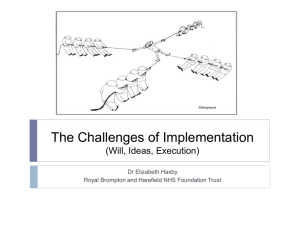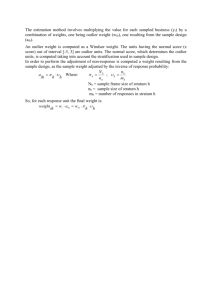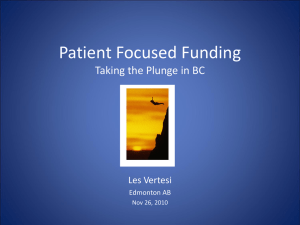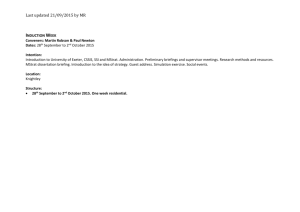Comparison of clinical registry data vs
advertisement
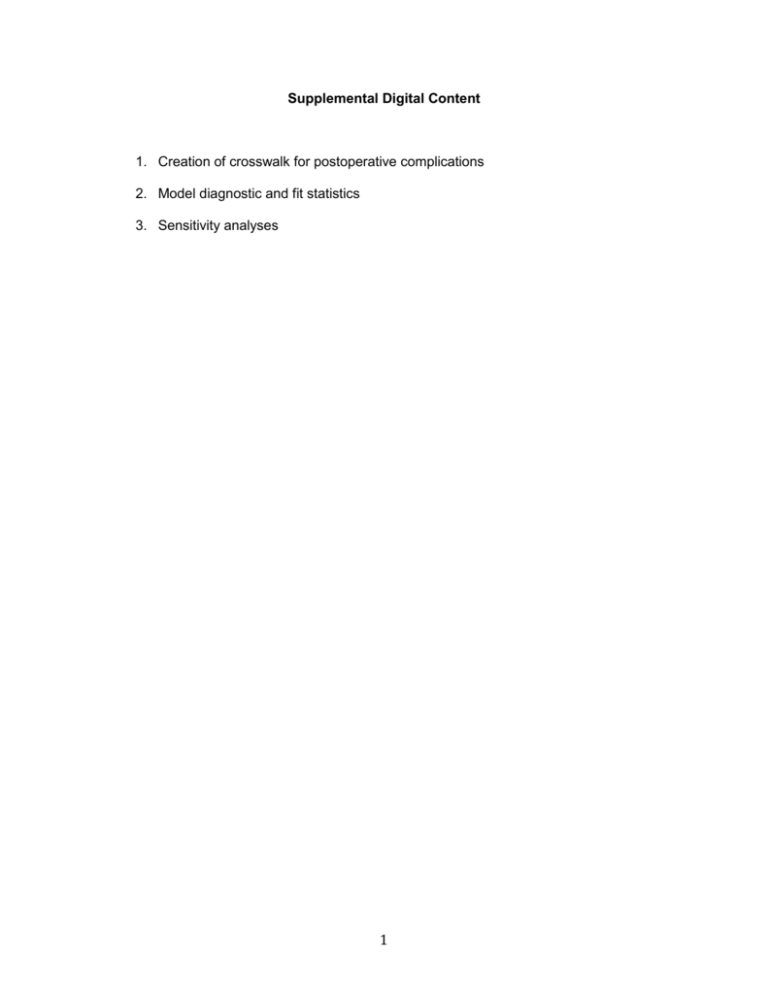
Supplemental Digital Content 1. Creation of crosswalk for postoperative complications 2. Model diagnostic and fit statistics 3. Sensitivity analyses 1 Supplemental Digital Content 1: Creation of crosswalk for postoperative complications In order to compare the data sources used in this study, we created a crosswalk that matches variables in ACS-NSQIP with applicable ICD-9 diagnosis codes in the Medicare data. This crosswalk was created through careful review and classification of applicable ICD-9 codes after consulting published literature as well as relevant measures from the Elixhauser Comorbidity Software,1 Quality Indicators from the Agency for Healthcare Research and Quality (AHRQ) 2 and the list of Hospital-Acquired Conditions from CMS. 3 We created and tested multiple variations of some Medicare variables to determine the optimal definition. When possible, we excluded codes that could represent a preoperative comorbidity rather than a postoperative complication, as “condition present-on-admission” qualifiers are not reported for MedPAR diagnosis codes. For example, we only included codes for acute myocardial infarction (ICD-9 code prefix 410) and excluded codes for old myocardial infarction (ICD-9 code prefix 412). In addition, the acute myocardial infarction ICD-9 code prefix requires a 4th digit indicating the location of the infarction and a 5th digit indicating whether it is the first episode of care for a newly diagnosed myocardial infarction (5th digit=1), a subsequent follow-up episode of care (5th digit=2) or unspecified (5th digit=0). Codes with a 5th digit of 2 were excluded. 2 Table 1. ICD-9 diagnosis codes used to identify 30-day postoperative complications in Medicare inpatient claims data. ACS-NSQIP Defined Postoperative ICD-9-CM Diagnosis Codes Complications Superficial SSI 9985, 99851, 99859 Deep/organ-space SSI 99859 Any SSI 9985, 99851, 99859 Urinary tract infection 1122, 5901*, 5903, 5908*, 5950, 5953, 5990, 99664 Pneumonia 0391, 1124, 1179, 1363, 46619, 480*, 481, 482*, 483*, 4841, 4846, 4847, 485, 486, 4870, 507*, 5130, 5168, 99731, 99739 Sepsis 038*, 78552, 99591, 99592, 9980 Deep venous thrombosis 4511*, 4512, 45181, 4534*, 4538, 4539 Pulmonary embolism 4151* Venous thromboembolism 4151*, 4511*, 4512, 45181, 4534*, 4538, 4539 Myocardial infarction 410*0, 410*1 We searched for codes included in the index admission or subsequent admissions within 30-days of surgery. For brevity, the * represents all 4th or 5th digits that could designate an ICD-9-CM code. For example, 4151* = 41511, 41512 and 41519. Any SSI includes superficial and/or deep and/or organ-space SSI. Venous thromboembolism includes deep venous thrombosis and/or pulmonary embolism. ACS-NSQIP, American College of Surgeons National Surgical Quality Improvement Program. SSI, surgical site infection. 3 Supplemental Digital Content 2: Model diagnostic and fit statistics The c-statistics and Hosmer-Lemeshow chi-square statistics for the hierarchical models were estimated by creating standard logistic regression models with the same covariates and hospital entered as a fixed effect (i.e. dummy variable for each hospital). Table 2. Model diagnostic and fit statistics Hosmer-Lemeshow chi-square statistic Outcome C-statistic AIC (p-value) ACS- ACSMedPAR NSQIP ACSMedPAR NSQIP 1.37 3.32 (0.99) (0.91) Deep/Organ- 10.80 3.65 space SSI (0.21) (0.89) 6.53 3.32 (0.59) (0.91) Urinary tract 3.84 39.18 infection (0.87) (<0.001) 28.57 49.35 (0.00) (<0.001) 30.96 10.07 (<0.001) (0.26) Deep venous 5.66 10.52 thrombosis (0.69) (0.23) MedPAR NSQIP 0.775 0.782 34719 32605 0.789 0.782 26253 31976 0.768 0.782 49524 32605 0.739 0.754 31033 52709 0.818 0.790 31825 41246 0.814 0.803 46606 55397 0.778 0.789 16592 19505 Superficial SSI Any SSI Pneumonia Sepsis 4 Pulmonary 10.58 70.08 embolism (0.23) (<0.001) Venous 3.88 3.58 thromboembolism (0.87) (0.89) Myocardial 7.64 23.11 infarction (0.47) (0.00) 28.50 86.34 (<0.001) (<0.001) Mortality 0.799 0.921 7838 5276 0.762 0.811 20632 21904 0.819 0.786 6867 23911 0.884 0.848 30994 36179 ACS-NSQIP, American College of Surgeons National Surgical Quality Improvement Program. MedPAR, Medicare Provider Analysis and Review file. SSI, surgical site infection. 5 Supplemental Digital Content 3: Sensitivity analyses To test the sensitivity of our results, we repeated the analyses with (1) the inclusion of additional Medicare sources representing outpatient visits; and (2) risk adjustment using only age and sex for all clinical and claims models. The results of the sensitivity analyses are reported in the tables below. 6 Table 3. Comparison of unadjusted hospital 30-day postoperative complication rates between a clinical surgical registry (ACS-NSQIP) and administrative data from Medicare comprehensive claims (MedPAR and outpatient data sources) for 192 hospitals Median hospital Median hospital Correlation of Agreement on percentage of percentage of hospitals’ hospitals’ decile rank patients with patients with postoperative for postoperative complication using complication using complication rates complication rate ACS-NSQIP data Medicare data between ACS- between ACS-NSQIP (interquartile (interquartile NSQIP vs. vs. Medicare range) range) Medicare (weighted kappa) 3.91% 5.66% Moderate Poor (2.25%-5.27%) (4.37%-7.16%) (0.41) (0.27) Deep/organ-space 2.78% 5.46% Moderate Poor SSI (1.69%-3.88%) (4.25%-7.06%) (0.45) (0.29) 6.54% 5.66% Moderate Poor (4.86%-8.52%) (4.37%-7.16%) (0.50) (0.34) 3.49% 11.00% Poor Poor (2.19%-4.56%) (9.14%-13.08%) (0.32) (0.23) 3.56% 8.97% Poor Poor (2.39%-5.30%) (7.01%-11.30%) (0.39) (0.25) 6.22% 12.40% Moderate Poor (4.38%-9.05%) (9.74%-15.09%) (0.53) (0.35) Deep venous 1.39% 4.52% Moderate Moderate thrombosis (0.82%-1.94%) (3.17%-6.24%) (0.63) (0.43) 0.54% 1.50% Moderate Poor (0.31%-0.87%) (1.09%-2.15%) (0.51) (0.35) Venous 1.79% 5.61% Moderate Moderate thromboembolism (1.29%-2.57%) (4.18%-7.38%) (0.64) (0.44) Outcomes Superficial SSI Any SSI Urinary tract infection Pneumonia Sepsis Pulmonary embolism 7 0.46% 3.33% Poor Poor (0.20%-0.73%) (2.43%-4.45%) (0.30) (0.19) Myocardial infarction Compare to Table 2 in main text. Any SSI includes superficial and/or deep and/or organspace SSI. Venous thromboembolism includes deep venous thrombosis and/or pulmonary embolism. ACS-NSQIP, American College of Surgeons National Surgical Quality Improvement Program. MedPAR, Medicare Provider Analysis and Review file. SSI, surgical site infection. 8 Table 4. Comparison of hospital risk-adjusted statistical outlier classification for 30-day postoperative complications between a clinical surgical registry (ACS-NSQIP) and administrative data from Medicare comprehensive claims (MedPAR and outpatient data sources) for 192 hospitals Number of Number of Agreement on Number statistical high Number of hospitals hospitals statistical low of outlier hospitals outlier status Number of outlier hospitals hospitals (worse than classification hospitals labeled as a labeled as an classified “high outlier” “outlier” by as low by ACS- ACS-NSQIP (better than classified expected Outcome Number of between expected as high performance) ACS-NSQIP performance) identified by each and Medicare outliers by NSQIP and a model and “as outliers identified by each by both data source (weighted both data “low outlier” expected” by data source data ACS- kappa) sources by Medicare, Medicare, or ACSMedicare sources NSQIP Medicare or vice versa vice versa 1 67 NSQIP Poor Superficial SSI 30 25 6 20 10 2 (0.08) Deep/organ-space Poor 20 24 2 13 7 3 1 52 SSI (0.07) Poor Any SSI 30 25 8 18 10 4 1 57 (0.20) Urinary tract Poor 25 24 5 14 20 4 4 57 infection (0.12) Poor Pneumonia 33 36 8 17 29 6 5 77 (0.11) Poor Sepsis 48 23 9 29 20 6 3 84 (0.12) Deep venous Poor 20 39 14 5 19 thrombosis 2 0 51 (0.31) 9 Pulmonary Poor 4 8 2 0 1 0 0 9 embolism (0.30) Venous Poor 20 37 12 5 18 3 0 50 thromboembolism (0.30) Poor Myocardial infarction 14 29 6 2 9 1 0 40 (0.19) Compare to Table 3 in main text. Outlier status was determined using the hospital intercept odds ratio from the applicable hierarchical multivariable logistic regression, as described in the text. A hospital was considered to be a high outlier (worse than expected performance) if its odds ratio was >1 (p<0.05) and a low outlier (better than expected performance) if its odds ratio was <1 (p<0.05). Hospitals with odds ratios not significantly different than 1 (p0.05) were labeled “as expected” for their given patient population. ACS-NSQIP, American College of Surgeons National Surgical Quality Improvement Program. MedPAR, Medicare Provider Analysis and Review file. SSI, surgical site infection. 10 Table 5. Comparison of hospital risk-adjusted statistical outlier classification for 30-day postoperative complications between a clinical surgical registry (ACS-NSQIP) and administrative data from Medicare inpatient claims (MedPAR) for 192 hospitals. All clinical and claims models include only age and sex for risk adjustment. Number of Number of Agreement on Number statistical high Number of hospitals hospitals statistical low of outlier hospitals outlier status Number of outlier hospitals hospitals (worse than classification hospitals labeled as a labeled as an classified “high outlier” “outlier” by as low by ACS- ACS-NSQIP (better than classified expected Outcome Number of between expected as high performance) ACS-NSQIP performance) identified by each and MedPAR outliers by NSQIP and a model and “as outliers identified by each by both data source (weighted both data “low outlier” expected” by sources by MedPAR, MedPAR, or or vice versa vice versa 3 69 data source data ACS- kappa) ACSMedPAR sources NSQIP MedPAR NSQIP Poor Superficial SSI 41 32 11 26 10 6 (0.19) Deep/organ-space Poor 33 32 11 15 9 5 2 53 SSI (0.26) Poor Any SSI 48 32 16 27 10 6 1 71 (0.26) Urinary tract Poor 32 27 7 22 22 6 2 73 infection (0.13) Poor Pneumonia 42 26 14 27 23 8 4 66 (0.26) Poor Sepsis 57 34 17 37 22 10 1 94 (0.21) Deep venous Poor 24 21 12 7 6 thrombosis 0 0 34 (0.35) 11 Pulmonary Poor 7 2 1 0 0 0 0 7 embolism (0.35) Venous Moderate 24 21 13 12 8 3 0 33 thromboembolism (0.44) Myocardial Poor 17 24 5 1 11 1 0 41 infarction (0.16) Excellent Mortality 22 28 21 16 16 12 0 16 0.78 Compare to Table 3 in main text. Outlier status was determined using the hospital intercept odds ratio from the applicable hierarchical multivariable logistic regression, as described in the text. A hospital was considered to be a high outlier (worse than expected performance) if its odds ratio was >1 (p<0.05) and a low outlier (better than expected performance) if its odds ratio was <1 (p<0.05). Hospitals with odds ratios not significantly different than 1 (p0.05) were labeled “as expected” for their given patient population. ACS-NSQIP, American College of Surgeons National Surgical Quality Improvement Program. MedPAR, Medicare Provider Analysis and Review file. SSI, surgical site infection. 12 REFERENCES 1. Elixhauser Comorbidity Software. (Accessed November 18, 2011, at http://www.hcup-us.ahrq.gov/toolssoftware/comorbidity/comorbidity.jsp.) 2. Agency for Healthcare Research and Quality (AHRQ) Quality Indicators. (Accessed November 18, 2011, at http://www.qualityindicators.ahrq.gov/Modules/iqi_overview.aspx.) 3. Hospital-Acquired Conditions (HAC) in Acute Inpatient Prospective Payment System (IPPS) Hospitals. Centers for Medicare & Medicaid Services, 2010. (Accessed November 18, 2011, at https://www.cms.gov/hospitalacqcond/downloads/hacfactsheet.pdf.) 13


